Binance Coin Price Analysis - Long term token prospects strong despite Coronavirus Black Swan
Introduction
Binance coin (BNB) is the native digital token of the mega Binance crypto exchange. BNB's investment profile is driven by multiple factors. It has established a prominent position in the crypto space as the utility exchange token that drives the Binance ecosystem forward.
BNB enjoyed an excellent start to Q1 2020, achieving strong gains in a rising crypto market. It has risen ~58% year-to-date and established a position as the 9th largest crypto asset on the Brave New Coin market cap table.
The Binance exchange opened in July 2017 with founder and CEO Changpeng Zhao still at the helm. Zhao had previously worked at blockchain.info from December 2013 until May 2014, and OKCoin as CTO from June 2014 until February 2015.
The BNB token ICO took place between July 1st, 2017 and July 21st, 2017. 100 million BNB tokens were sold, raising US$15 million with a token price of US$0.15. Notable investors and advisors included Matthew Roszak, Roger Ver of Bitcoin.com, and Da Hongfei of NEO.
_The BNB token has multiple use cases within the Binance ecosystem, including; _
- Access to cheaper transaction fees and liquidity options on Binance.com, Binance.US, the Binance DEX, margin trading
- Early/discounted access to Binance Launchpad IEO sales
- To pay for on-chain operations like smart contract executions and validator payments on the Binance chain blockchain that powers the Binance DEX
Binance was originally founded in China, but moved to Japan in late 2017 and had offices in Taiwan by March 2018. Shortly thereafter, Binance announced a move to Malta to open a fiat-to-crypto exchange.
However, last week the Malta Financial Services Authority (MFSA) issued a statement denying it had given permission to Binance to operate under its jurisdiction. The regulator said that Binance "is not authorized by the MFSA to operate in the cryptocurrency sphere and is therefore not subject to regulatory oversight by the MFSA."
In response, CZ tweeted, “Binance is not headquartered or operated in Malta. There are misconceptions some people have on how the world must work a certain way, you must have offices, HQ, etc. But there is a new world with blockchain now. Binance has a number of regulated entities around the world, either operated by our partners or by Binance directly. Binance has always operated in a decentralized manner as we reach out to our users across more than 180 nations worldwide. As well as pushing the envelope in experimenting on how to become a true DAO.”
The growth of Binance is bullish for BNB
In February 2020, the company extended its fiat-to-crypto trading by adding support for 15 new fiat-crypto purchasing options (via Visa/Mastercard). Many of the new on-ramps are unique and may help further cement Binance’s status as a one-stop-shop for crypto trading. New pairs include the New Zealand dollar (NZD), Polish złoty (PLN), South African rand (ZAR), Hungarian forint (HUF), and Israeli Shekel (ILS).
_ _
Complementing Binance’s growing fiat-to-crypto onramps is a continued appetite for crypto-to-crypto trading. The above chart (BTC USD/USDT), compares the aggregated daily USD crypto market volumes for the BTC/USDT & BTC/USD pairs. These are two of the most traded pairs across crypto, and the BTC/USDT pair remains the Binance spot exchange’s most traded pair while BTC/USD is the top pair for significant exchange’s like Coinbase pro. Currently the 24hr trading volume of the BTC/USD market is just 12.68%
As per BNC market data, the aggregated BTC/USDT pair generated ~US$370 million on 01/01/2019 and ~US$7.3 billion on 19/02/2020, a 19x increase in just over a year._ _The continued and apparently growing demand for crypto-to-crypto and stablecoin-to-crypto trading likely remains a key driver of profitability for Binance.
BNB adds to its utility coin status with an equity-like function - profits earned by Binance through trading fees are redistributed to BNB holders in the form of a token burn, functioning in a similar manner to a dividend.
The Binance community recently conducted its 10th annual quarterly BNB coin burn (October- December 2019). The group burnt 2,216,888 BNB, worth ~US$ 38.8 million, the 2nd highest BNB coin burn in history.
The most recent quarter’s burn included revenue earnt in trading fees across spot, options and for the first time ever, its futures market. The scale of Binance’s operations grew rapidly in 2019, as part of an aggressive blitz-scaling strategy. Binance has added many new features over the last year, including a range of new fiat-to-crypto trading pairs in new markets and 125x margin trading contracts. These have helped the exchange sustain its trading revenues despite bearish market conditions affecting demand for crypto spot trading.
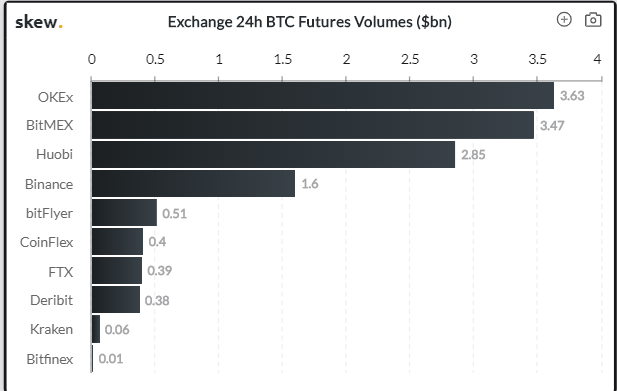
Despite the presence of a number of incumbents, the Binance futures market has emerged as a top 5 platform thanks to its 125x margin trading products and easy integration for Binance spot trades Source: skew.com
A November 2019 report by Multicoin Capital compared Binance’s aggressive corporate growth model to blitz-scaling, a term coined by Silicon valley legend Reid Hoffman who helped propel Paypal and Linkedin to software giant status._ _In Hoffman’s own words, _“When a market is up for grabs, the risk isn’t inefficiency—the risk is playing it too safe. If you win, efficiency isn’t that important; if you lose, efficiency is completely irrelevant.” _When companies blitz-scale they deliberately make, and commit to major strategic decisions without 100% confidence.
The blitz-scaling strategy is inherently risky, with operational inefficiencies and empty losses inevitable. Some companies like Binance, however, are able to cover for these ‘small’ losses by using profits earned from other more established parts of the business. In the last 8 months, for example, a number of key on-chain metrics for the Binance chain have decreased significantly.
The inherent value of the BNB token has likely remained intact, however, because the Binance.com spot exchange continues to achieve large volumes daily through its best-in-class KYC-less, off-chain crypto-to-crypto services. It’s value is also buoyed by BNB’s strong long term investment horizon.
Network metrics
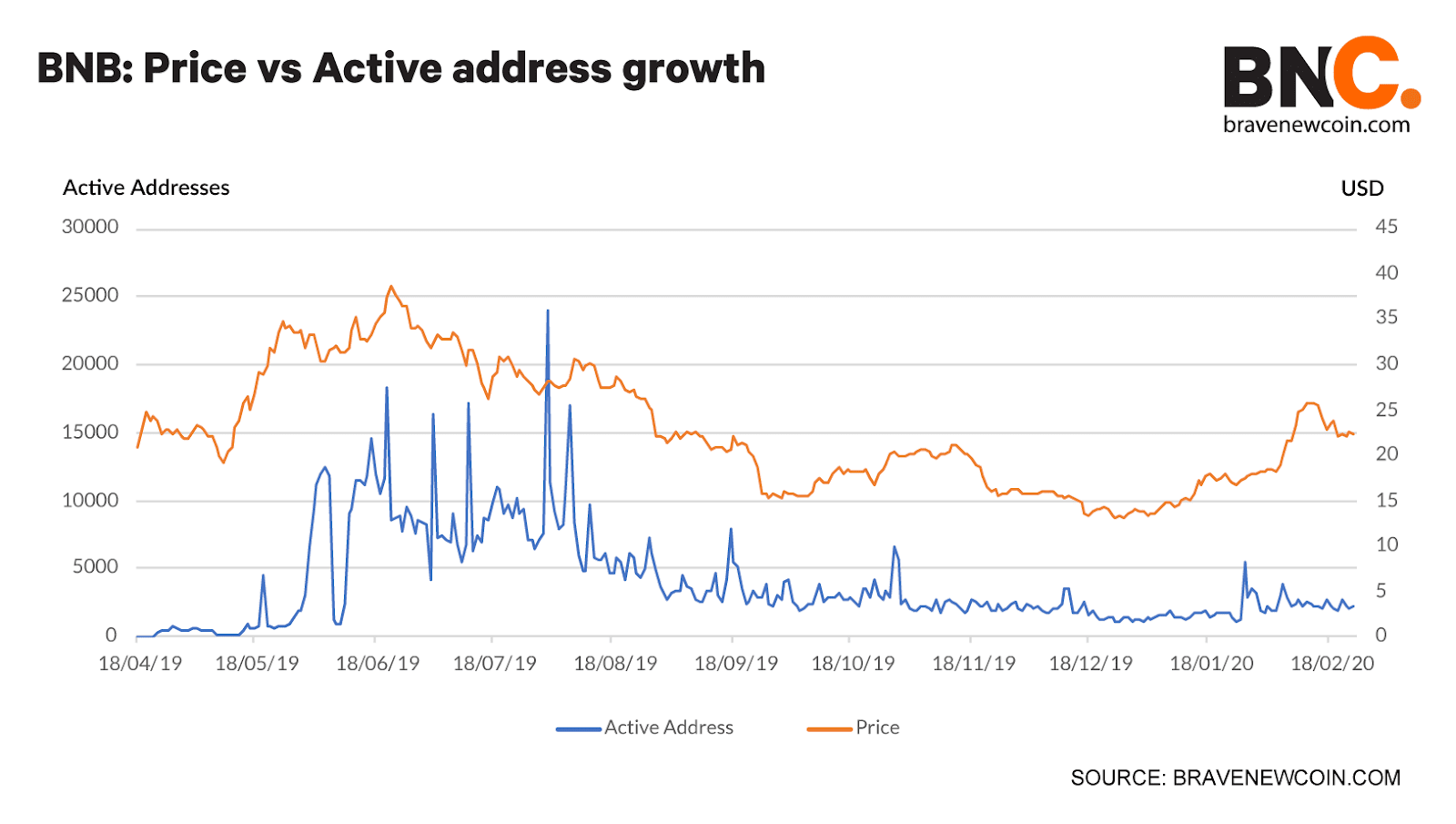
Onchain data source: Coinmetrics community data
Daily Active addresses are defined as accounts/addresses on the Binance chain network that were either recipients or originators of transactions on the Binance chain on a given day. It is generally considered an indicator for the size of a token’s network effects, an essential driver of value and utility for decentralized networks.
Following an immediate increase in daily active addresses in the first few months after the chain launched, since mid-August 2019 daily active address activity has dropped. It now sits well under 5000 active users a day, a significant fall from 23,964 active users in July 2019.
Generally, a drop in active addresses over an extended period can be a strong bearish fundamental indicator for a crypto asset. The BNB token’s value, however, is not limited by its utility as a medium for payments and services on the Binance chain. This means other factors like speculative buying decisions made by traders are more likely to influence the price of the token.
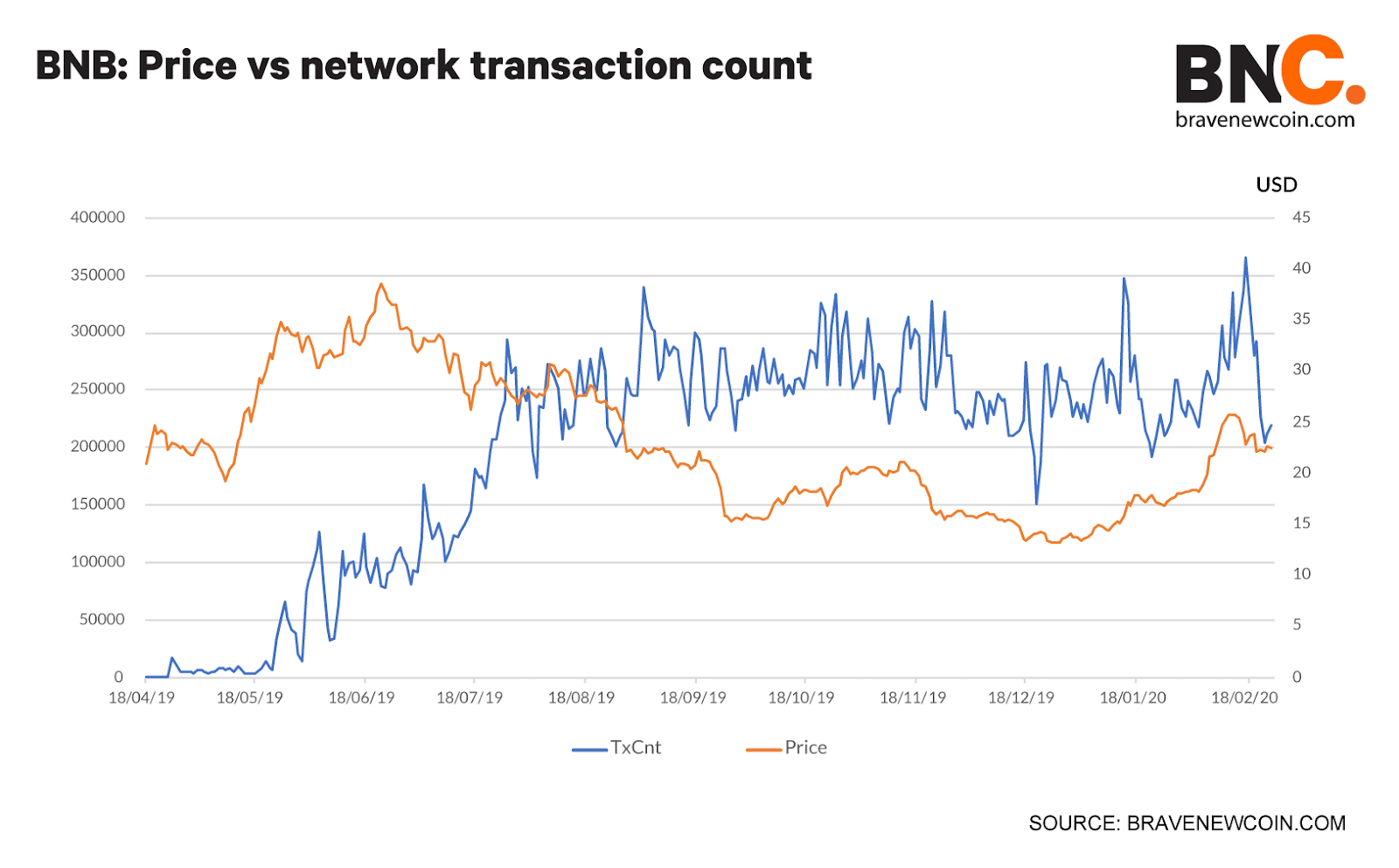
Onchain data source: Coinmetrics community data
Unlike the bearish signals sent by the Binance chain active address metrics, the network’s transaction count stats lean bullish. Consistently over the last 8 months, daily transaction counts have hit consistently higher highs, with the current trend peaking at 366,224 transactions on 17th February 2020.
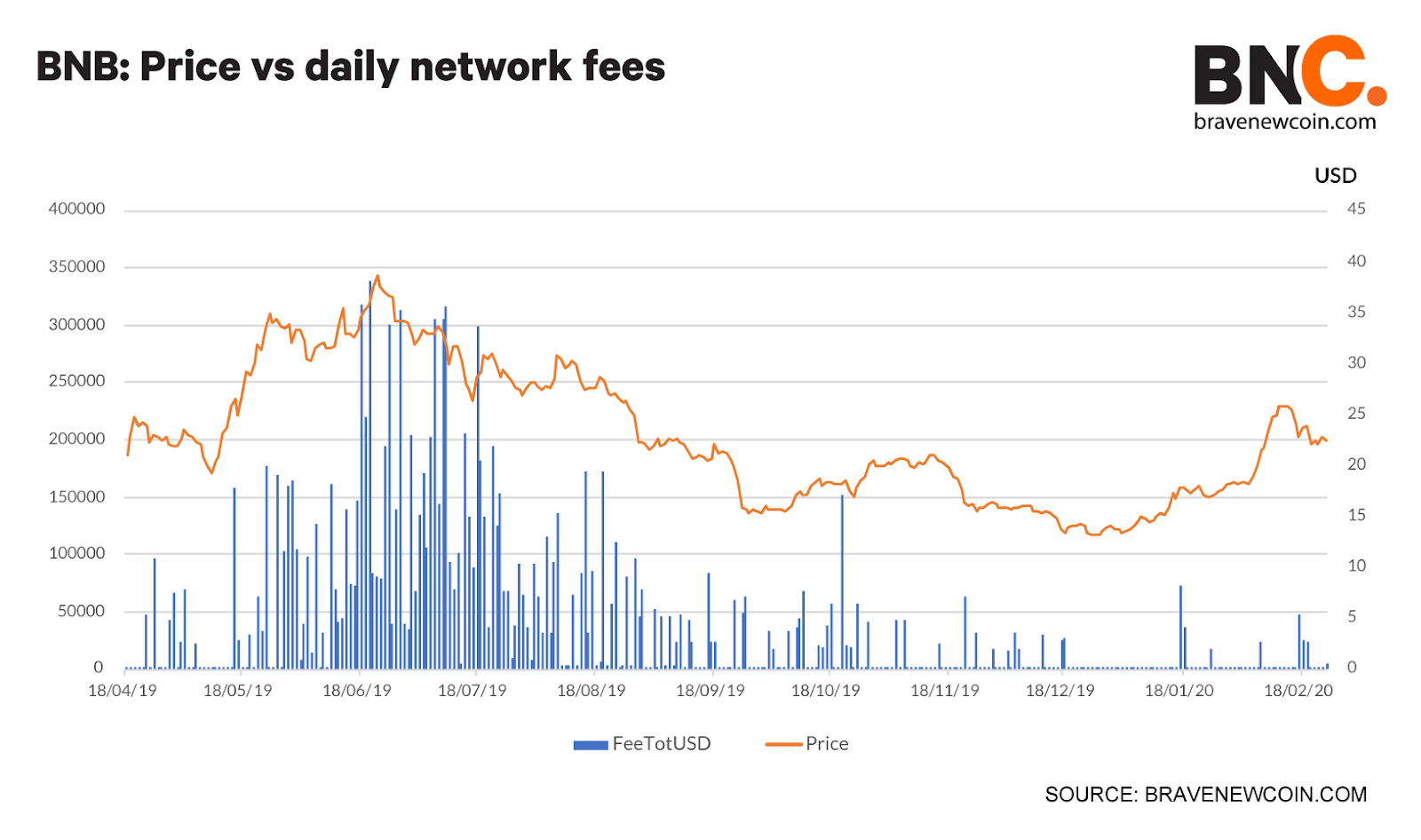
Daily network fees, however, tell a different story to transaction counts. Similar to the Binance chain active addresses metric, it leans bearish. The falling USD fees earnt daily by the network over the last 8 months suggest a possible ‘wait and see’ approach by the market.
The Binance chain is still in an earlier stage of development compared to other platform chains like Ethereum. It has fewer Dapp and DEX solutions than other platforms and there is less external interest to develop on top of it. The nature of Binance’s blitz-scaling strategy as well as internal documentation, suggests that the Binance chain will be a primary point of focus for the group in the future.
One would expect the on-chain activity of the Binance chain to grow in the future and drive more usage of the BNB token. Currently, however, these metrics are being led by the price of BNB, or speculative buying pressure, not actual on-chain usage.
The Coronavirus is a short-term headwind
The price of the Binance token has fallen ~31% since the 13th of February and is enduring a period of strong bearish selling pressure - over the same period the price of Bitcoin has fallen 17%. In traditional markets, the Dow Jones industrial index has fallen by ~8%, translating into enormous capitalization losses unusual for such a large index which requires a great deal of money to move.
The values of both the Crypto and traditional markets have suffered heavily over the last two weeks driven by negative macro headwinds caused by fears of a Coronavirus pandemic. Investors across the board are now jittery about the investment prospects of nearly all available investment vehicles because of a potential global outbreak of the virus. Speaking to investors Nigel Green, CEO and founder of the DeVere investment group was frank.
_“It does seem that this week the world is waking up to the reality of the situation as the containment of coronavirus hasn’t yet materialised and confirmed cases soar in different countries,” said Green. “Until such time as governments pump liquidity into the markets and coronavirus cases peak, markets will be jittery triggering sell-offs.” _
He added,_“Investors have largely been caught off-guard by the serious and far-reaching economic consequence of the coronavirus.” _
On the BNB/USD daily chart, the 50-day EMA and 200-day EMAs bullishly crossed on February 14th, with price returning to the 200-day EMA this week. Typically, bullish trend confirmation occurs once the 200-day EMA has been confirmed as support. Both volume and RSI show no signs of bullish or bearish divergences. Substantial volume support (horizontal bars) sits at US$12-16 as well as US$9.75. Overhead resistance peaks at US$22 and decreases above that level until the all-time high at US$40.
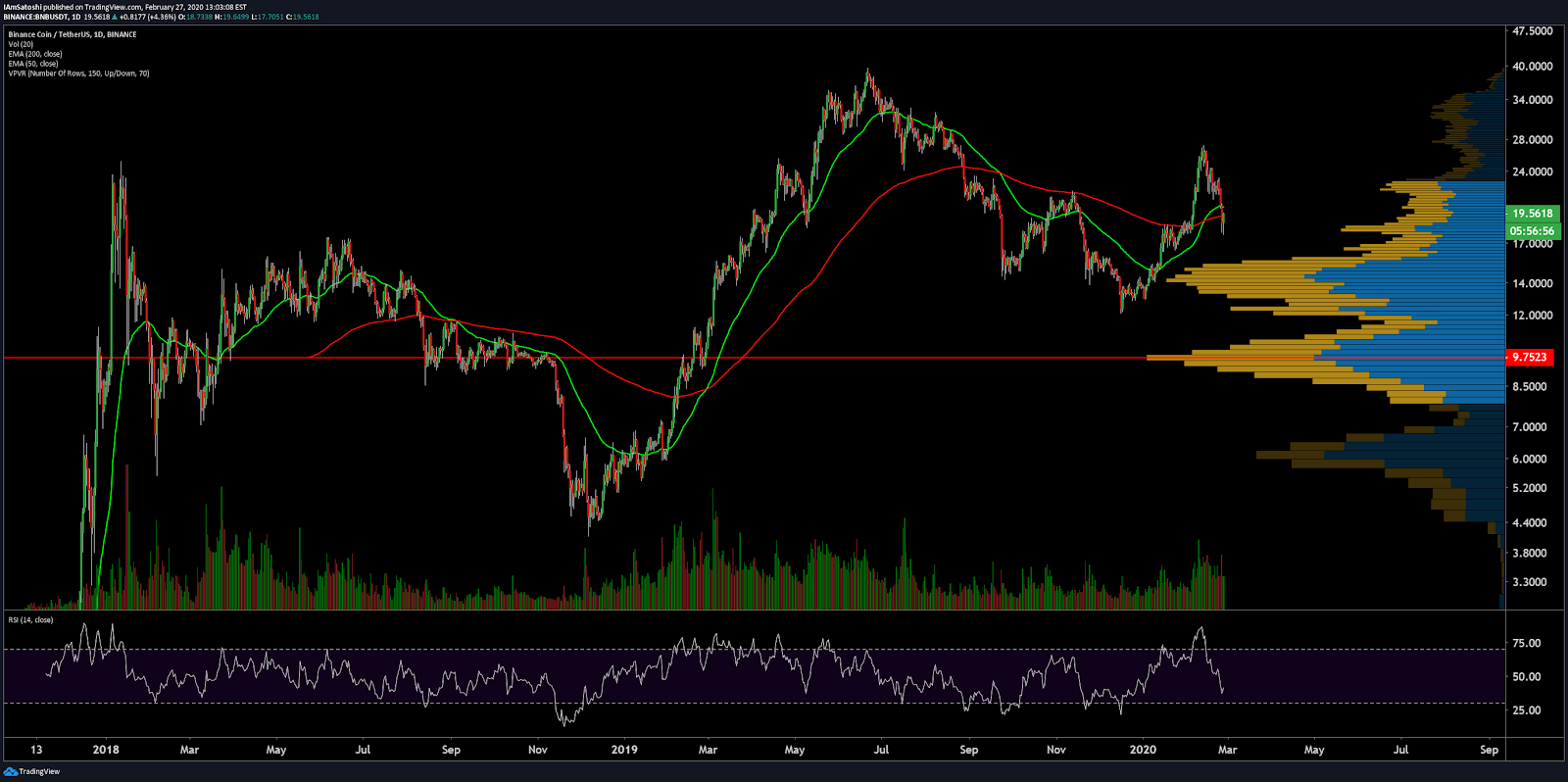
Turning to the Ichimoku Cloud, four metrics are used to indicate if a trend exists; the current price in relation to the Cloud, the color of the Cloud (red for bearish, green for bullish), the Tenkan (T) and Kijun (K) cross, and the Lagging Span. The best entry always occurs when most of the signals flip from bearish to bullish, or vice versa.
Cloud metrics on the daily time frame, with doubled settings (20/60/120/30) for more accurate signals, are currently bullish; the spot price is above the Cloud, the Cloud is bullish, the TK cross is bullish, and the Lagging Span is above Cloud and above price. The trend will remain bullish as long as the spot price is above the Cloud. The previous bullish Kumo breakout resulted in a 400% move from February to June 2019.

On the BNB/BTC daily chart, the 50-day EMA and 200-day EMAs are nearly bullishly crossed with price above the Cloud. Bullish trend confirmation will occur if the Golden Cross occurs. Both volume and RSI show no signs of bullish or bearish divergences. Price shows small overhead resistance until the previous local high at 0.0026 BTC and significant resistance near 0.0038. Significant support sits at 0.0015 BTC.
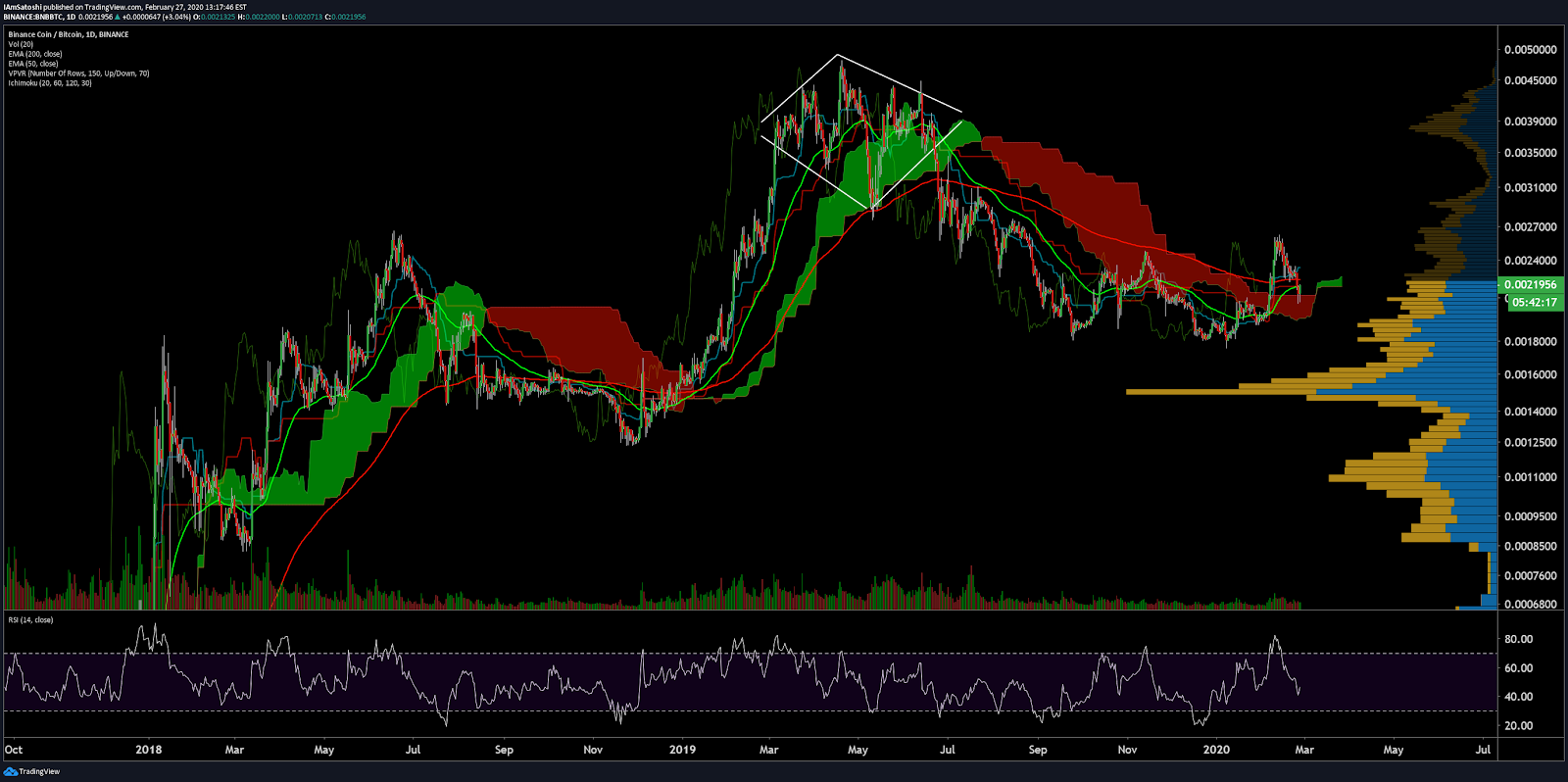
Conclusion
Long term investment prospects for the BNB token remain bullish thanks to continued strong market demand for Binance’s market leading crypto-to-crypto spot trading solutions. This success has translated into a number of large coin burns that have compensated long time holders. The overall utility of the BNB token also continues to grow rapidly, with new Binance features like the recently released futures marketplace rewarding users who pay and use BNB tokens.
The BNB token’s recent price slide has likely been driven by external negative macro headwinds. Fears around the economic and financial consequences of Corona continue to spread with more deaths and outbreaks in new countries being announced every day. The price of BNB may continue to fall in the short term because of this apparent black swan event.
Technicals for both BNB pairs show trend metrics consistent with a nascent bullish trend. The BNB/USD pair shows moderate resistance from US$12-16 with a confirmed bullish trend. The BNB/BTC pair shows moderate resistance to the previous local high at 0.0026 BTC with an unconfirmed bullish trend. BNB token burns and daily active addresses (DAA) have historically heavily influenced a bullish BNB token price. Historically since 2018, BNB has been most bullish in Q1 and Q2 and more bearish in Q3 and Q4 of any given year.
OhNoCrypto
via https://www.ohnocrypto.com
Aditya Das, Khareem Sudlow
